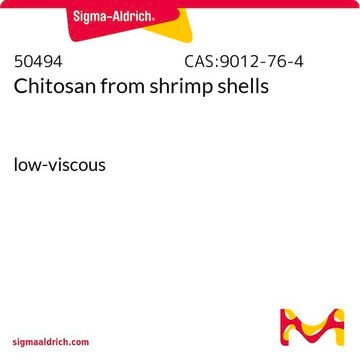The degree of acetylation should be above 75% for each lot, but the exact value will vary. For information on the degree of acetylation for a particular lot, contact the local technical service team.
48165
Chitosan from crab shells
highly viscous
Synonyme(s) :
2-Amino-2-deoxy-(1→4)-β-D-glucopyranan, Poly-(1,4-β-D-glucopyranosamine)
About This Item
Produits recommandés
Source biologique
(crab)
Forme
powder
Impuretés
≤1% insoluble matter
Résidus de calcination
≤2% (as SO4)
Perte
≤12% loss on drying
Couleur
yellow
Viscosité
>400 mPa.s, 1 % in acetic acid(20 °C)
InChI
1S/C56H103N9O39/c1-87-56(86)65-28-38(84)46(19(10-74)96-55(28)104-45-18(9-73)95-49(27(64)37(45)83)97-39-12(3-67)88-47(85)20(57)31(39)77)103-54-26(63)36(82)44(17(8-72)94-54)102-53-25(62)35(81)43(16(7-71)93-53)101-52-24(61)34(80)42(15(6-70)92-52)100-51-23(60)33(79)41(14(5-69)91-51)99-50-22(59)32(78)40(13(4-68)90-50)98-48-21(58)30(76)29(75)11(2-66)89-48/h11-55,66-85H,2-10,57-64H2,1H3,(H,65,86)/t11-,12-,13-,14-,15-,16-,17-,18-,19-,20-,21-,22-,23-,24-,25-,26-,27-,28-,29-,30-,31-,32-,33-,34-,35-,36-,37-,38-,39-,40-,41-,42-,43-,44-,45-,46-,47-,48+,49+,50+,51+,52+,53+,54+,55+/m1/s1
Clé InChI
FLASNYPZGWUPSU-SICDJOISSA-N
Vous recherchez des produits similaires ? Visite Guide de comparaison des produits
Description générale
Application
Autres remarques
Code de la classe de stockage
11 - Combustible Solids
Classe de danger pour l'eau (WGK)
nwg
Point d'éclair (°F)
Not applicable
Point d'éclair (°C)
Not applicable
Équipement de protection individuelle
Eyeshields, Gloves, type N95 (US)
Faites votre choix parmi les versions les plus récentes :
Déjà en possession de ce produit ?
Retrouvez la documentation relative aux produits que vous avez récemment achetés dans la Bibliothèque de documents.
-
What is the degree of deacetylation of this reagent?
1 answer-
Helpful?
-
-
What is the molecular weight of this chitosan (ref 48165)?
1 answer-
The molecular weight for this product is not analyzed on a lot to lot basis. However, the expected range is 500,000 to 700,000 g/mol.
Helpful?
-
-
Greetings I wish to know if this chitosan is soluble or insoluble in water. I also realized that there is water-soluble chitosan. Please kindly clarify the difference. I need them to do laboratory experiments.
1 answer-
This product has not been tested for it's solubility in water. However, one gram chitosan can be dissolved in a mixture of 100mL 10% acetic acid and 50mL methanol, and then precipitated from a precipitant consisted of 10mL ethanol and 90mL acetate ester. The treated chitosan should become soluble in acid-free water completely at 8.02mg/mL
Helpful?
-
Active Filters
Notre équipe de scientifiques dispose d'une expérience dans tous les secteurs de la recherche, notamment en sciences de la vie, science des matériaux, synthèse chimique, chromatographie, analyse et dans de nombreux autres domaines..
Contacter notre Service technique



